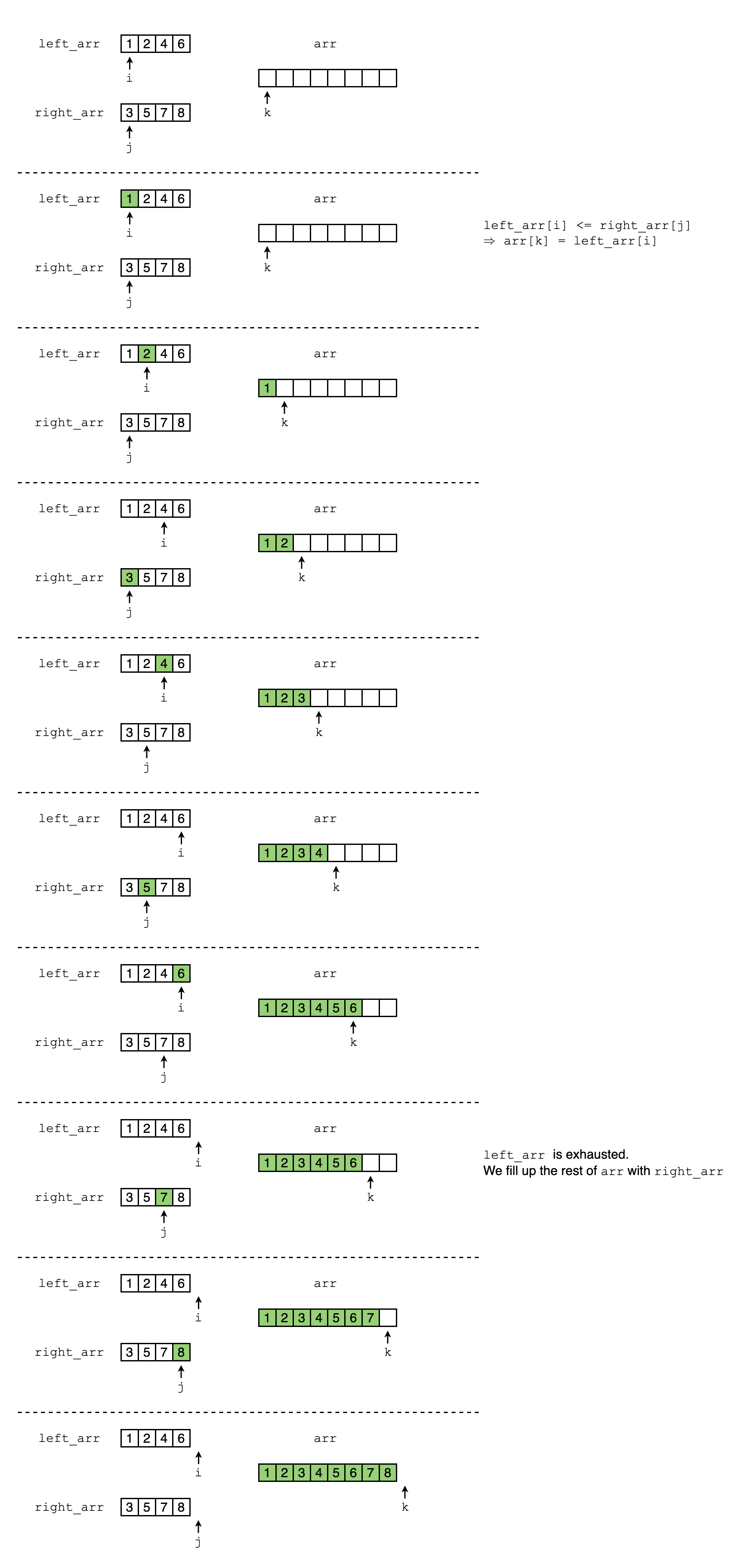Merge Sort
TL;DR
- Merge sort use Divide and Conquer strategy
- Repeatedly divides the array into two subarrays until subarrays of size 1
- Merge two sorted array to achieve a bigger sorted array
- Time complexity is
- Space complexity is (non-inplace)
How Merge Sort Works?
Divide and Conquer Strategy
Merge Sort is one of the most popular sorting algorithms that is based on the principle of Divide and Conquer.
Using the Divide and Conquer technique, we divide a problem into subproblems. When the solution to each subproblem is ready, we “combine” the results from the subproblems to solve the main problem.
Suppose we had to sort an array arr. A subproblem would be to sort a sub-section of this array starting at index p and ending at index r, denoted as arr[p..r].
Divide
If
qis the half-way point betweenpandr, then we can split the subarrayarr[p..r]into two arraysarr[p..q]andarr[q+1, r].Conquer
In the conquer step, we try to sort both the subarrays
arr[p..q]andarr[q+1, r]. If we haven’t yet reached the base case, we again divide both these subarrays and try to sort them.Combine
When the When the conquer step reaches the base step and we get two sorted subarrays
arr[p..q]andarr[q+1, r]for arrayarr[p..r], we combine the results by creating a sorted arrayarr[p..r]from two sorted subarraysarr[p..q]andarr[q+1, r]
The MergeSort Algorithm
- Repeatedly divides the array into two halves until we reach a stage where we try to perform MergeSort on a subarray of size 1 (the base case)
- Combine the sorted arrays into larger sorted arrays until the whole array is merged.
Implementation
Merge: merge two sorted arrays to a larger sorted array
def merge(left_arr, right_arr, arr):
"""
Merge left_arr and right_arr to arr.
left_arr and right_arr are already sorted.
After merging, arr should be sorted.
"""
left_len = len(left_arr)
right_len = len(right_arr)
i = 0 # Mark the position of current smallest element in left_arr
j = 0 # Mark the position of current smallest element in right_arr
k = 0 # Mark the position to be filled in arr
while (i < left_len and j < right_len): # left_arr and right_arr are not exhausted
# We compare the current smallest elements of left_arr and right_arr,
# fill arr with the smaller one
if left_arr[i] <= right_arr[j]:
arr[k] = left_arr[i]
i += 1
else:
arr[k] = right_arr[j]
j += 1
k += 1
if i > left_len - 1:
# left_arr is exhausted.
# Thus, we fill up the rest of arr with right_arr
arr[k:] = right_arr[j:]
if j > right_len - 1: \
# right_arr is exhausted
# Thus, we fill up the rest of arr with left_arr
arr[k:] = left_arr[i:]
return arr
arr = [2, 4, 1, 6, 8, 5, 3, 7]
left_arr = [1, 2, 4, 6]
right_arr = [3, 5, 7, 8]
merge(left_arr, right_arr, arr)
[1, 2, 3, 4, 5, 6, 7, 8]

Merge sort
def merge_sort(arr):
print(arr)
# Base case
if len(arr) < 2:
return arr
# Divide
mid = len(arr) // 2
left_arr = arr[:mid]
right_arr = arr[mid:]
# Conquer
merge_sort(left_arr)
merge_sort(right_arr)
# Combine
merge(left_arr, right_arr, arr)
print(f"Merge {left_arr} and {right_arr} --> {arr}\n")
return arr
arr = [2, 4, 1, 6, 8, 5, 3, 7]
print(merge_sort(arr))
[2, 4, 1, 6, 8, 5, 3, 7]
[2, 4, 1, 6]
[2, 4]
[2]
[4]
Merge [2] and [4] --> [2, 4]
[1, 6]
[1]
[6]
Merge [1] and [6] --> [1, 6]
Merge [2, 4] and [1, 6] --> [1, 2, 4, 6]
[8, 5, 3, 7]
[8, 5]
[8]
[5]
Merge [8] and [5] --> [5, 8]
[3, 7]
[3]
[7]
Merge [3] and [7] --> [3, 7]
Merge [5, 8] and [3, 7] --> [3, 5, 7, 8]
Merge [1, 2, 4, 6] and [3, 5, 7, 8] --> [1, 2, 3, 4, 5, 6, 7, 8]
[1, 2, 3, 4, 5, 6, 7, 8]

Complexity Analysis
Time Complexity
Best/Average/Worst Case Complexity:
Space Complexity
The space complexity of merge sort is .